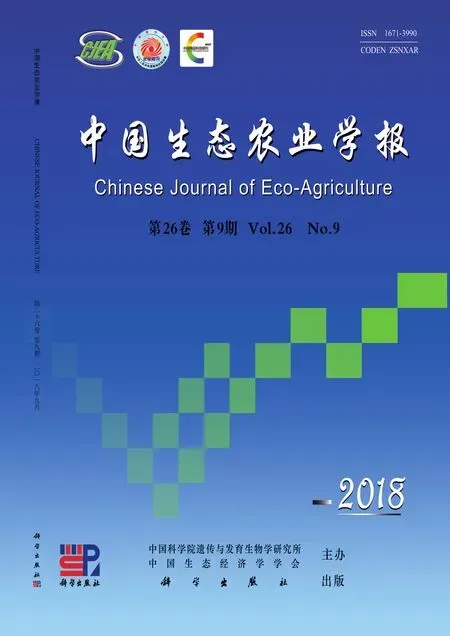杂交水稻恢复系和杂交组合的耐热性评价*
郭晓艺, 熊 洪, 张 林, 蒋 鹏, 朱永川, 周兴兵, 刘 茂, 徐富贤
杂交水稻恢复系和杂交组合的耐热性评价*
郭晓艺, 熊 洪, 张 林, 蒋 鹏, 朱永川, 周兴兵, 刘 茂, 徐富贤**
(四川省农业科学院水稻高粱研究所/农业部西南水稻生物学与遗传育种重点实验室/作物生理生态及栽培四川省重点实验室 德阳 618000)
为减缓高温热害对水稻生产的影响, 从品种出发探讨高温抗性, 是水稻科研的优先领域和重大问题。本文参考农业部发布的高温行业标准评价指标, 在水稻开花期, 于人工气候室高温和常温处理条件下, 对本课题组新育成的恢复系及生产上常用恢复系成恢727的配组品种(组合)等进行了耐高温特性鉴定, 并将恢复系和品种(组合)耐热性分为5个等级。筛选鉴定出1个极耐热恢复系R4093、9个耐热恢复系(其中包括丰产性较好的恢复系, 如R1015、R107等)、4个极耐热品种(组合)和25个耐热品种(组合), 以及5个极不耐热恢复系、12个不耐热品种(组合)和6个极不耐热品种(组合)等。其中, 耐高温对照N22、恢复系R103、R132、R642、杂交水稻品种(组合)‘川优5727’、‘宜香2115’、‘繁源A×R642’、‘中64香A×黄占’、‘川农优华占’、‘蓉18A×R1015’、‘渝香6203’和‘川优5727’在本试验中的常温结实率和相对结实率均高于70%, 虽然被鉴定为中间型材料, 但具有较大的耐高温潜力。试验还讨论了水稻品种的生产布局。结果表明: 第Ⅰ级和第Ⅱ级品种耐高温性较好, 可布局在高温易发区、高温轻发区和无高温区; 第Ⅲ类品种为中间型, 可布局在高温轻发区和无高温区; 第Ⅳ类和第Ⅴ类品种为不耐热型和极不耐热型, 可布局在无高温区, 以避免高温对水稻的伤害。研究还发现父(母)本耐高温性好, 不一定品种(组合)耐高温性都好, 而父(母)本耐高温性不好, 其品种(组合)耐高温性也不一定不好, 这与父(母)本的耐高温性及配合力有关。耐热配合力好的父(母)本配出的组合多为耐热型组合, 耐热配合力差的父(母)本配出的组合多为不耐热型组合。其中, 恢复系R105、R642、R104和R727耐高温配合力较好, 但恢复系R107、R1015耐高温配合力相对较差。不育系赣73A和内香6A的耐高温配合力较好, 而繁源A、606A、608A和中64香A的耐高温配合力较差。优质稻中‘金10’耐高温配合力较好。为了更好更多地育成耐热性强的杂交稻组合, 筛选耐热配合力高的亲本是关键。
农业行业标准; 杂交水稻; 恢复系; 高温热害; 耐热性; 父(母)本; 配合力
水稻()是中国的主要粮食作物, 在国家粮食安全战略中占有主导地位[1]。随着温室效应和极端异常天气的频繁出现, 高温热害导致的水稻减产日益严重。特别是中国西南稻区每年规律性的7月中旬至8月下旬38 ℃以上极端高温, 给水稻生产造成严重损失。高温热害不仅会导致花粉发育异常, 活力下降, 还会抑制颖花开放和花药开裂程度, 阻碍传粉和受精, 造成结实率下降[2-7]。因此, 高温热害已成为影响我国特别是长江中上游水稻生长发育及高产稳产的主要限制因素之一。
为了减缓高温热害对水稻生产的影响, 从品种出发探讨抗高温是水稻科研的优先领域和重大问题。近年来, 国内外水稻工作者已经筛选鉴定出一批耐高温水稻材料及品种。符冠富等[8]对我国常用恢复系和保持系进行了耐热性研究, 结果表明我国恢复系多属于不耐热性材料, 而不育系耐热性明显高于恢复系。陈云风等[9]通过采用抗高温性全逆境鉴定技术, 在抽穗扬花期35 ℃全逆温处理11 d, 以高温结实率为指标对5个恢复系进行了耐热性评价, 筛选出两个较强耐热恢复系, 并表明籼稻资源中有更大的机会获得强耐热性的稻种资源。胡声博等[10]在水稻开花期于人工气候箱38 ℃下处理3 d, 对100个杂交水稻品种进行了耐热性鉴定, 以相对结实率为指标筛选划分了3个耐热类型, 并表明大部分具有相同母本的组合表现出一致的耐热性, 说明母本对杂交水稻的耐热性起主导作用。熊洪等[11]通过人工气候箱39 ℃高温处理1 d和自然条件下分期播种, 以耐热系数和高温结实率分别对四川16个杂交稻品种进行了耐高温特性研究, 划分了3个耐热类型, 并针对耐热类型对水稻生产布局提出了建议。张林等[12]在水稻开花期于人工气候箱38 ℃下处理3 d, 以相对受精率为指标对西南稻区62个水稻品种进行了耐热性鉴定, 并根据耐热类型提出了水稻生产布局建议。万丙良等[1]通过分期播种和玻璃温室38 ℃下处理至开花结束, 以高温结实率为指标对恢复系R1056及其配组杂交稻进行了耐热性鉴定, 发现恢复系R1056是一个耐高温杂交水稻恢复系, 其所配杂交组合耐高温性介于R1056和高温敏感品种之间。由于国内生产上应用的品种繁多, 且评价标准不统一, 导致相同水稻品种在不同试验条件和评价方法时, 耐高温特性均有很大的差异。为提高试验结果的可靠性以及对指导生产布局的针对性与实用性, 本试验参考农业部颁布的高温行业标准, 对本课题组新育成的水稻恢复系及生产上常用恢复系成恢727及其配组组合等进行了耐高温特性鉴定, 并分析了其在杂交稻育种中的应用价值和配组导致组合耐热性变化规律, 为解决我国特别是长江中上游杂交水稻高温危害奠定了基础。
1 材料与方法
1.1 供试材料
以95个水稻杂交组合及恢复系为试验材料, 其中恢复系24份, 杂交稻组合70个, 以N22作为耐高温对照。供试恢复系和杂交组合详见表1。水稻于3月5日播种, 4月13日移栽到塑料盆中, 每盆种2穴, 每品种(系)种植8盆(每个处理4盆)。
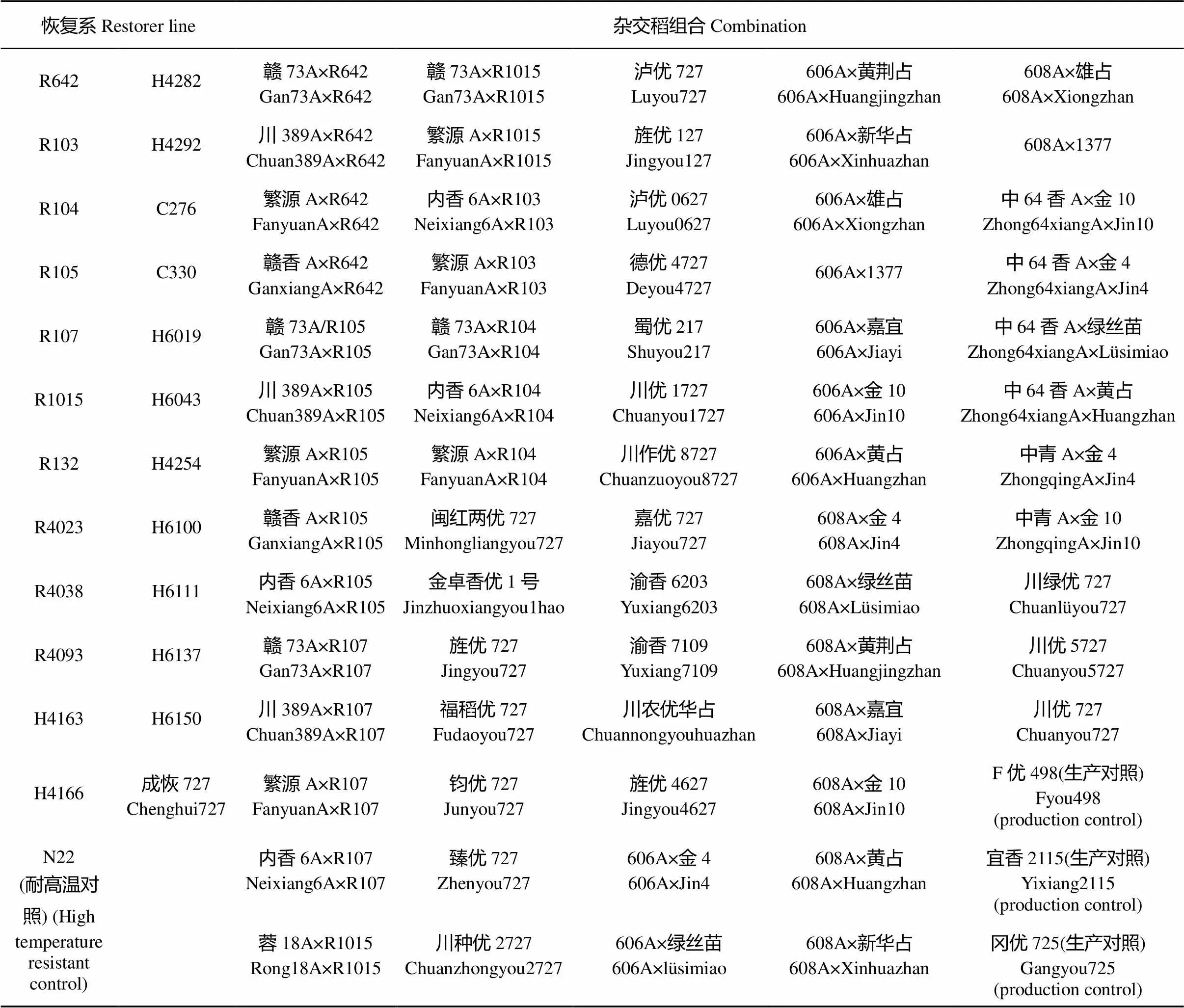
表1 试验所用水稻恢复系和杂交组合
1.2 试验处理
在四川省泸县(29°10¢N, 105°23¢E)采用两个人工气候箱(LT/ACR-2002型, 北京易盛泰和科技有限公司)进行处理, 气候箱湿度控制在80%。一个人工气候箱为高温处理, 最高温为38 ℃; 另一个为常温控制, 最高温为32 ℃, 以常温温度为对照。两个人工气候室温度时段设置见表2。
供试品种和材料均为中稻, 不同品种和材料的抽穗时间相差不大, 均在7月中旬至下旬, 正值泸县高温干旱时期。本试验采用同期播种、同期移栽的方法, 每个处理重复4次, 水肥统一常规管理。在水稻抽穗开花期将生长于室外整齐一致的稻株于早上8:00一半移入高温人工气候箱, 一半移入常温气候箱, 处理5 d。移入前剪去已经开的颖花, 并挂牌记录。处理结束后将全部盆栽植株放回网室统一浅水管理。
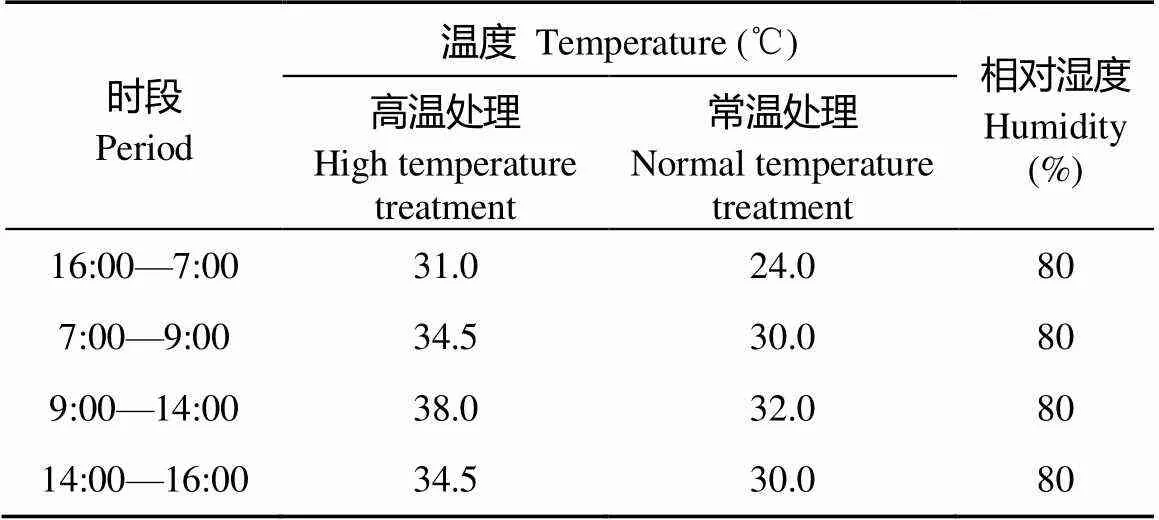
表2 用于水稻栽培的人工气候室一天的温度与湿度设置
1.3 考察项目
成熟期分别取开花期高温处理和对照处理的挂牌稻穗, 每穴均取3~5穗, 共4穴, 用于考察其饱满粒数、秕粒数和空粒数。计算每个品种的水稻结实率和相对结实率。
水稻结实率=(饱满粒数+秕粒数)/(饱满粒数+秕粒数+空粒数)×100% (1)
相对结实率=高温处理结实率/对照处理 结实率×100% (2)
1.4 数据分析
采用Statistix 8.0进行数据分析。
2 结果与分析
2.1 恢复系耐热性评价及生产布局
根据2016年10月农业部发布的高温行业标准(NY/T 2915—2016), 以水稻相对结实率≥95%作为强耐热型, 75%≤相对结实率<95%作为耐热型, 55%≤相对结实率<75%作为中间型, 35%≤相对结实率<55%作为不耐热型, 相对结实率<35%作为极不耐热型对供试恢复系进行分级(表3)。本试验筛选出1个极耐热恢复系R4093, 其相对结实率高达96.18%; 以及9个耐热恢复系, 分别是H4292、H4254、R1015、H6150、H6019、C276、R107、R105、H6137, 相对结实率变幅在75.13%~89.78%, 均高于对照N22; 耐高温对照N22、恢复系R103、R132、R642在本试验中的常温结实率和相对结实率均高于70%, 虽然被鉴定为中间型材料, 但具有较大的耐高温潜力。本试验还筛选出3个不耐热恢复系和5个极不耐热恢复系, 通过高温结实率与对照结实率进行检验结果发现, 极不耐热恢复系在高温条件下结实率极显著降低, 只有5.12%~ 27.88%, 且相对结实率小于35%, 而自然条件下这些恢复系的结实率均大于80%。也就是说这些恢复系于无高温地区种植可获得较高的产量。而恢复系C330在高温与对照条件下的结实率均较低, 只有26.43%和51.27%, 有可能是生长过程中遇到其他不良因素所致, 需要进一步进行研究。
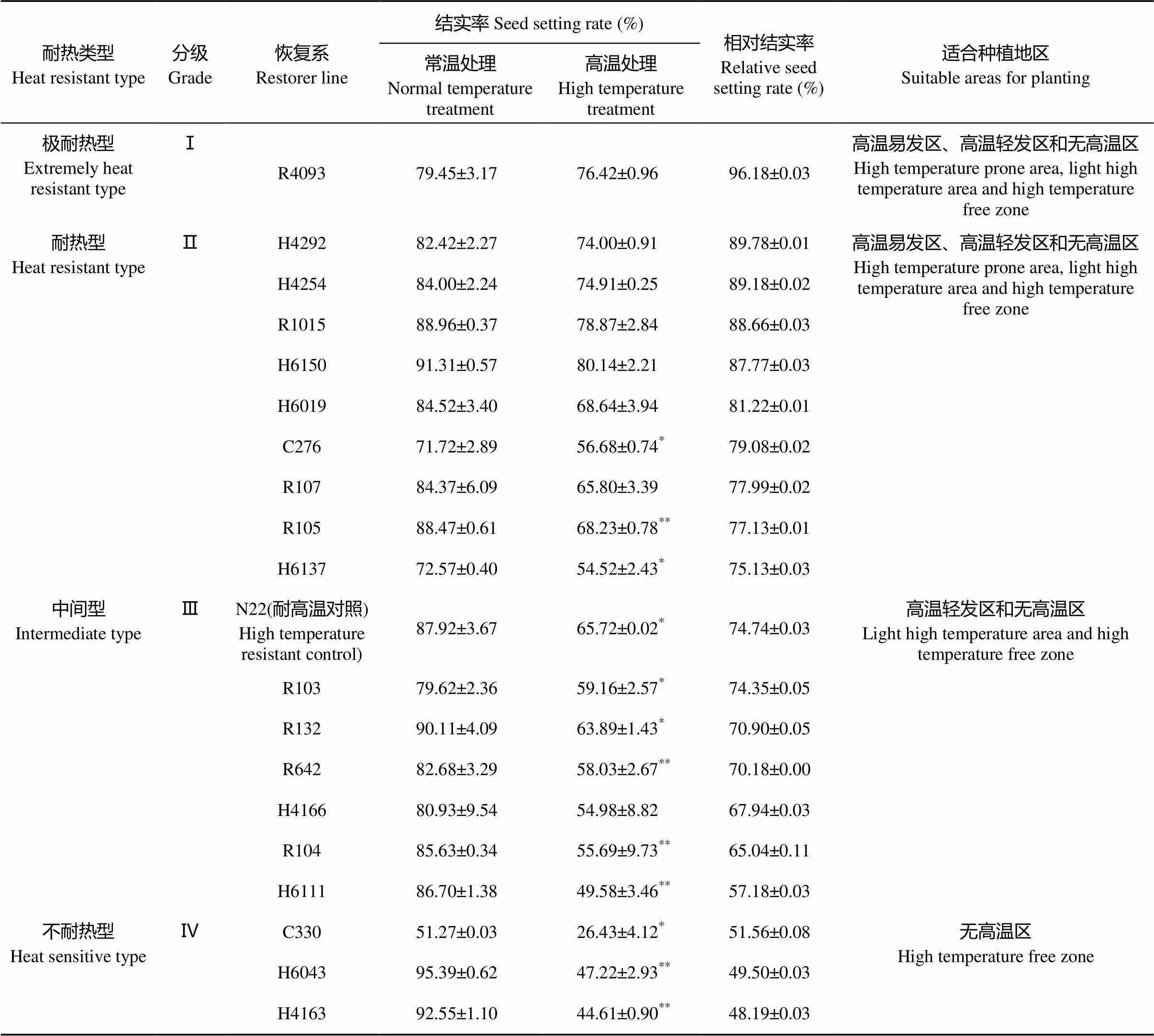
表3 杂交水稻恢复系在开花期人工高温与常温下的耐热性表现

耐热类型Heat resistant type分级Grade恢复系Restorer line结实率Seed setting rate (%)相对结实率Relative seed setting rate (%)适合种植地区Suitable areas for planting 常温处理Normal temperature treatment高温处理High temperaturetreatment 极不耐热型Extremely heat sensitive typeⅤ成恢727 Chenghui72789.57±1.7227.88±3.45**31.14±0.03无高温区High temperature free zone R403891.74±0.0428.25±1.05**30.79±0.01 H428282.73±2.2424.18±0.25**29.24±0.03 H402388.20±1.0620.71±1.31**23.47±0.02 H610083.04±2.485.12±0.72**6.16±0.10
*和**代表同一恢复系(品种)在高温、常温处理下差异显著(≤0.05)和极显著(≤0.01)。以相对结实率≥95%作为强耐热型(Ⅰ级)、75%≤相对结实率<95%为耐热型(Ⅱ级)、55%≤相对结实率<75%为中间型(Ⅲ级)、35%≤相对结实率<55%作为不耐热型(Ⅳ级)和相对结实率<35%为极不耐热型(Ⅴ级)对供试恢复系进行分级。相对结实率=高温处理结实率/对照处理结实率×100%。* and ** indicate significant differences between treatments of normal temperature and high temperature of the same restorer line (combination) at 0.05 and 0.01 levels, respectively. The grading criteria of heat resistant type (grade) is as the following: the relative seed setting rate ≥ 95% is the extremely heat resistant type (grade Ⅰ); 75% ≤ the relative seed setting rate < 95% is the heat resistant type (grade Ⅱ); 55% ≤ the relative seed setting rate < 75% is the intermediate type (grade Ⅲ); 35% ≤ the relative seed setting rate < 55% is the heat sensitive type (grade Ⅳ); the relative seed setting rate < 35% is the extremely heat sensitive type (grade Ⅴ). Relative seed setting rate = high temperature seed setting rate / normal temperature seed setting rate × 100%.
根据以上分级结果(表3), 第Ⅰ级和第Ⅱ级耐高温性较好, 相对结实率均大于75%, 可布局在高温易发区、高温轻发区和无高温区。第Ⅲ类为中间型恢复系, 相对结实率变辐在57.18%~74.74%, 此类恢复系可布局在高温轻发区和无高温区。第Ⅳ类和第Ⅴ类恢复系为不耐热型和极不耐热型恢复系, 有8个恢复系, 此类恢复系相对结实率变辐为6.16%~51.56%, 在高温易发区生产风险较大, 应避开水稻开花期高温地区种植, 可布局在无高温区。
2.2 杂交品种(组合)耐热性评价及生产布局
根据农业部发布的高温行业标准(NY/T 2915— 2016)以及表4可知, 本试验筛选出4个极耐热品种, 包括‘金卓香优1号’、‘川种优2727’、‘闽红两优727’和‘旌优4627’, 其相对结实率均高于95%, 具有极强的耐热性。25个耐热品种(组合), 相对结实率变幅在75.14%~94.67%。耐高温对照‘N22’、‘川优5727’、‘宜香2115’、‘繁源A×R642’、‘中64香A×黄占’、‘川农优华占’、‘蓉18A×R1015’、‘渝香6203’在本试验中的对照结实率和相对结实率均高于70%, 说明具有较大耐高温潜力。本试验还筛选出12个不耐热杂交稻组合和6个极不耐热杂交稻组合, 应布局在无高温地区种植可获得较高的产量。‘606A×金4’、‘606A×黄荆占’、‘608A×金4’、‘608A×黄荆占’这4个组合由于高温结实率和对照结实率都较低(3.88%~11.64%, 40.65%~ 52.81%), 有可能是生长过程中遇到其他不良因素所致, 需要进一步研究。由于耐热与敏感型材料划分标准只是一个相对标准, 且试验条件不同, 鉴定结果也不同, 因此, 上述边缘材料(组合)很可能变为极耐热、耐热、不耐热或极不耐热型材料(组合), 在生产应用上要特别注意风险。
根据品种(组合)分级结果(表4), 第I级和第Ⅱ级耐高温性较好, 相对结实率均大于75%, 可布局在高温易发区、高温轻发区和无高温区。第Ⅲ类为中间型品种(组合), 相对结实率变辐在56.39%~74.74%, 此类组合可布局在高温轻发区和无高温区。第Ⅳ类和第Ⅴ类组合为不耐热型和极不耐热型, 此类组合相对结实率变辐在7.35%~54.11%, 可布局在无高温区, 以避免高温对水稻的伤害。
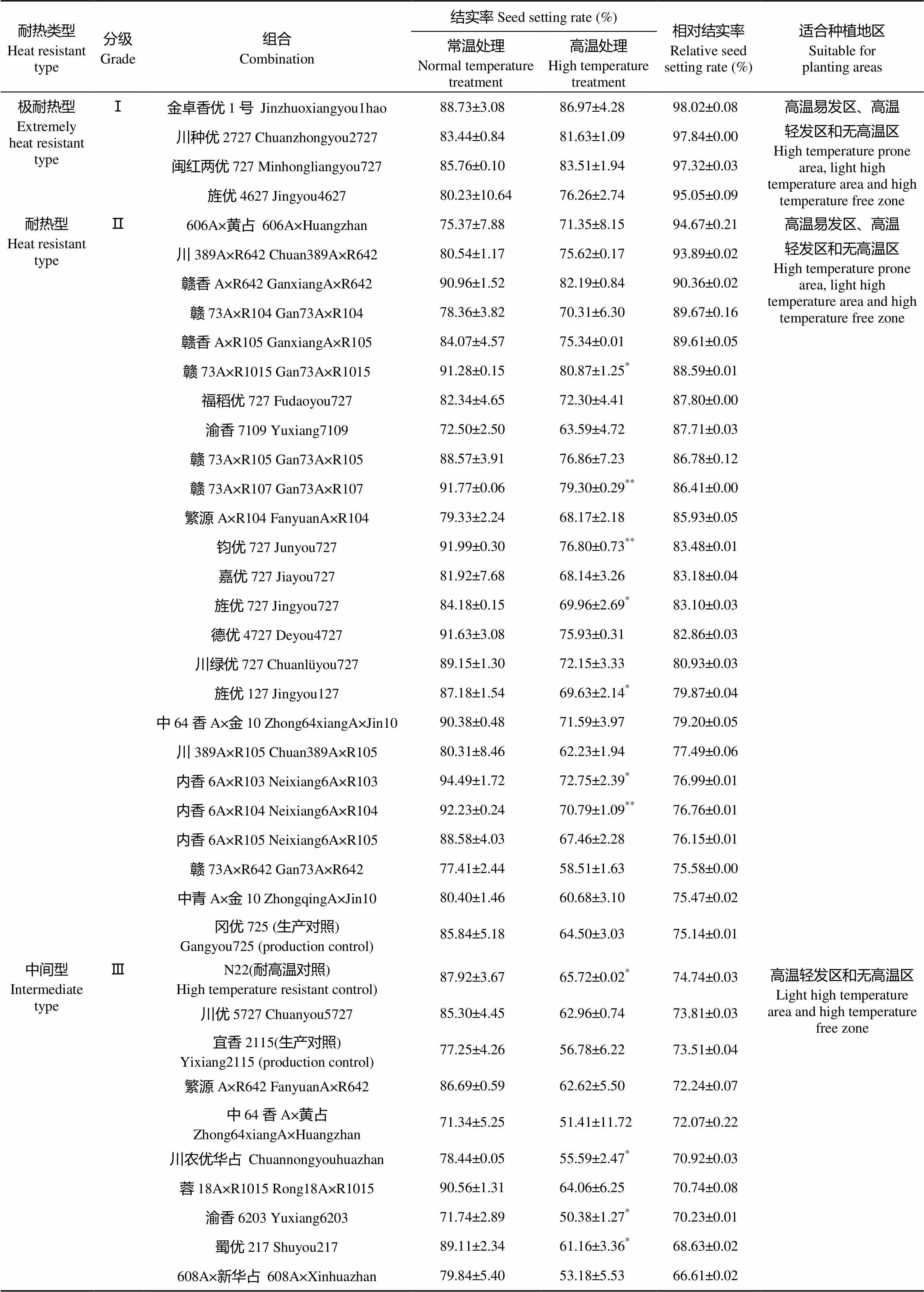
表4 杂交水稻品种(组合)在开花期人工高温和常温下的耐热性表现

耐热类型Heat resistant type分级Grade组合Combination结实率Seed setting rate (%)相对结实率Relative seed setting rate (%)适合种植地区Suitable forplanting areas 常温处理Normal temperaturetreatment高温处理High temperaturetreatment 中间型Intermediate typeⅢF优498(生产对照) Fyou498 (production control)93.95±1.2562.58±1.36**66.60±0.02高温轻发区和无高温区Light high temperature area and high temperature free zone 泸优727 Luyou72777.01±9.3150.97±4.9966.19±0.02 608A×金10 608A×Jin1079.80±2.8152.50±2.89*65.79±0.06 川香3727 Chuanxiang372791.73±0.7959.51±1.46**64.88±0.01 泸优0627 Luyou062789.08±2.4456.09±0.01**62.96±0.02 繁源A×R105 FanyuanA×R10585.40±0.6953.16±5.14*62.25±0.06 川优727 Chuanyou72792.83±1.1655.90±3.87*60.21±0.05 繁源A×R107 FanyuanA×R10772.99±4.0843.45±3.00*59.52±0.00 内香6A×R107 Neixiang6A×R10788.17±1.6052.31±2.01**59.33±0.01 608A×嘉宜608A×Jiayi61.91±0.7036.70±1.55*59.28±0.03 川优1727 Chuanyou172782.86±1.7748.69±0.79**58.768±0.02 606A×嘉宜606A×Jiayi84.12±3.7949.31±6.0158.61±0.05 608A×黄占608A×Huangzhan75.17±4.9543.88±2.75*58.37±0.08 中64香A×绿丝苗 Zhong64xiangA×Lüsimiao76.82±0.1344.56±12.3558.00±0.16 606A×雄占 606A×Xiongzhan78.30±1.0444.61±4.05*56.98±0.04 繁源A×R1015 FanyuanA×R101587.31±2.8049.23±8.5556.39±0.08 不耐热型Heat sensitive typeⅣ中青A×金4 ZhongqingA×Jin476.99±1.9641.66±1.57**54.11±0.03无高温区High temperature free zone 606A×金10 606A×Jin1073.56±2.8539.38±2.3753.54±0.05 608A×雄占 608A×Xiongzhan72.13±2.9837.48±0.41*51.97±0.02 608A×绿丝苗 608A×Lüsimiao61.09±2.8831.30±8.4351.24±0.16 川香优727 Chuanxiangyou72790.42±0.4242.28±0.92**46.76±0.01 繁源A×R103 FanyuanA×R10386.10±1.6840.12±0.11**46.59±0.01 中64香A×金4 Zhong64xiangA×Jin477.59±2.2635.43±7.8745.67±0.11 臻优727 Zhenyou72785.83±3.0538.63±3.42*45.01±0.06 606A×绿丝苗 606A×Lüsimiao80.51±2.5030.48±4.50*37.85±0.07 川作优8727 Chuanzuoyou872787.56±3.1432.87±1.44*37.54±0.00 川389A×R107 Chuan389A×R10787.96±1.9532.78±0.40**37.27±0.00 606A×新华占 606A×Xinhuazhan84.33±0.3030.08±4.90*35.67±0.06 极不耐热型 Extremely heat sensitive typeⅤ608A×金4 608A×Jin445.27±2.6911.64±5.36*25.72±0.10无高温区 High temperature free zone 606A×137771.83±1.9118.02±7.82*25.09±0.10 608A×137769.46±1.4813.37±6.82*19.24±0.09 606A×金4 606A×Jin440.65±0.045.63±4.60*13.87±0.11 606A×黄荆占606A×Huangjingzhan49.21±0.633.93±0.51**7.98±0.01 608A×黄荆占 608A×Huangjingzhan52.81±3.273.88±1.55**7.35±0.03
*和**分别代表同一恢复系(品种)在高温、常温处理下差异显著(≤0.05)和极显著(≤0.01)。以相对结实率≥95%作为强耐热型(Ⅰ级)、75%≤相对结实率<95%为耐热型(Ⅱ级)、55%≤相对结实率<75%为中间型(Ⅲ级)、35%≤相对结实率<55%作为不耐热型(Ⅳ级)和相对结实率<35%为极不耐热型(Ⅴ级)对供试杂交稻组合进行分级。相对结实率=高温处理结实率/对照处理结实率×100%。* and ** indicate significant differences between treatments of normal temperature and high temperature of the same restorer line (combination) at 0.05 and 0.01 levels, respectively. The grading criteria of heat resistant type (grade) is as the following: the relative seed setting rate ≥ 95% is the extremely heat resistant type (grade Ⅰ); 75% ≤ the relative seed setting rate < 95% is the heat resistant type (grade Ⅱ); 55% ≤ the relative seed setting rate < 75% is the intermediate type (grade Ⅲ); 35% ≤ the relative seed setting rate < 55% is the heat sensitive type (grade Ⅳ); the relative seed setting rate < 35% is the extremely heat sensitive type (grade Ⅴ). Relative seed setting rate = high temperature seed setting rate / normal temperature seed setting rate × 100%.
2.3 成恢727配组的21个审定品种耐高温性分析
成恢727是由四川省农业科学院作物研究所利用亲本‘成恢177’和‘蜀恢527’杂交选育而成的恢复系。近年来, 成恢727选配出了许多抗性好、品质及产量优的组合, 并作为主推品种在生产上被广泛利用。我们对其配组的21个审定品种进行了高温鉴定, 结果表明(表5), 21个审定品种筛选出‘金卓香优1号’、‘川种优2727’、‘闽红两优727’、‘旌优4627’这4个极耐热杂交稻品种和7个耐热杂交水稻品种, 共占总数的52.4%, 这些品种的耐热性均高于耐高温对照‘N22’和生产对照‘宜香2115’、‘F优498’。‘川优5727’的对照结实率和相对结实率均大于70%, 说明其具有较高的耐热潜力, 也说明了成恢727虽然耐热性不好, 但具有较高的耐热配合力。另外, 这21个审定品种中也筛选出9个中间型品种和3个不耐热品种。由此说明, 以极不耐热恢复系作为父本配组的不同杂交稻品种, 其耐热性有较大差异, 并不都是不耐热的, 相反还有较大比例极耐热品种和耐热品种。因此, 品种的耐热性并不是完全由父本耐热性决定的, 父本耐热配合力及母本的耐热性与配合力也起到重要作用。
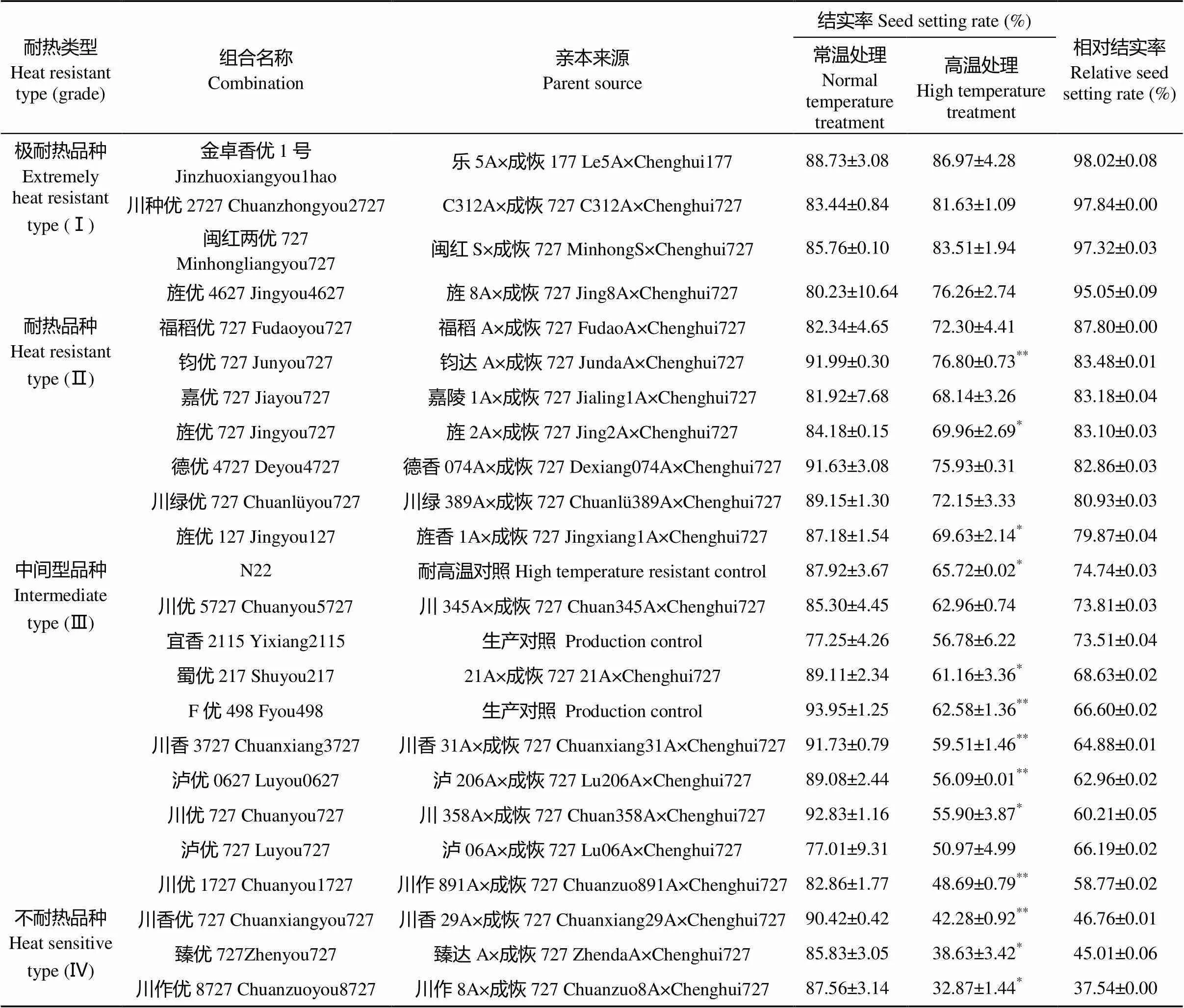
表5 成恢727配组的21个审定品种耐高温性分析
*和**分别代表同一恢复系(品种)在高温、常温处理下差异显著(≤0.05)和极显著(≤0.01)。以相对结实率≥95%为强耐热型(Ⅰ级)、75%≤相对结实率<95%为耐热型(Ⅱ级)、55%≤相对结实率<75%为中间型(Ⅲ级)、35%≤相对结实率<55%为不耐热型(Ⅳ级)和相对结实率<35%为极不耐热型(Ⅴ级)对供试品种进行分级。相对结实率=高温处理结实率/对照处理结实率×100%。* and ** indicate significant differences between treatments of normal temperature and high temperature at 0.05 and 0.01 levels, respectively. The grading criteria of heat resistant type (grade) is as the following: the relative seed setting rate ≥ 95% is the extremely heat resistant type (grade Ⅰ); 75% ≤ the relative seed setting rate < 95% is the heat resistant type (grade Ⅱ); 55% ≤ the relative seed setting rate < 75% is the intermediate type (grade Ⅲ); 35% ≤ the relative seed setting rate < 55% is the heat sensitive type (grade Ⅳ); the relative seed setting rate < 35% is the extremely heat sensitive type (grade Ⅴ). Relative seed setting rate = high temperature seed setting rate / normal temperature seed setting rate × 100%.
2.4 不同父母本所配杂交组合耐高温性分析
由表6可知, 以恢复系R105为父本与川389A、繁源A、赣香A、内香6A、赣73A 5个不育系配组, 除‘繁源A×R105’为中间型组合外, 其余均表现为耐热杂交稻组合, 耐热组合占总数的80%, 说明R105具有较好的耐热性和耐高温配合力; 以恢复系R642为父本同样与赣73A、川389A、繁源A、赣香A配组, 除‘繁源A×R642’被鉴定为中间型杂交组合外, 其余3个均为耐高温杂交稻组合, 占总数的75%, 说明R642不仅具有耐高温潜力, 耐热配合力也较好。而恢复系R107为父本与川389A、繁源A、内香6A、赣73A 4个不育系配组, 只有‘赣73A×R107’被鉴定为耐热型组合, 占总数的25%, 说明虽然R107耐高温性较好, 但其配合力较差; 同样, 以恢复系R1015为父本与不育系赣73A、蓉18A、繁源A配组, 只有‘赣73A×R1015’表现为耐高温杂交稻组合, 耐高温组合占总数的33%, 因此, R1015虽然也属于耐热型恢复系, 但耐高温配合力较差。以恢复系R104与不育系内香6A、赣73A、繁源A配组, 所配组合均为耐热型组合, 说明R104虽然属于中间型恢复系, 但其耐高温配合力较好。
以不育系繁源A为母本与恢复系R105、R642、R107、R1015、R104、R103配组, 除‘繁源A×R104’为耐高温杂交稻组合外, 其他5个均为中间型或不耐热组合, 耐热组合占总数的17%。因此, 繁源A的耐高温配合力较差。以内香6A为母本的配组结果可知, 除‘内香6A×R107’为中间型组合外, 其他3个均为耐热型组合, 耐热组合占总数的75%。因此, 内香6A的耐高温配合力较好。由不育系赣73A与恢复系R105、R642、R107、R1015、R104配组情况看, 所有组合均被鉴定为耐热型组合, 占总数的100%, 说明赣73A的耐高温配合力非常好。由于本试验未对供试组合的保持系进行高温鉴定, 因此, 母本的耐高温性还需进一步研究。
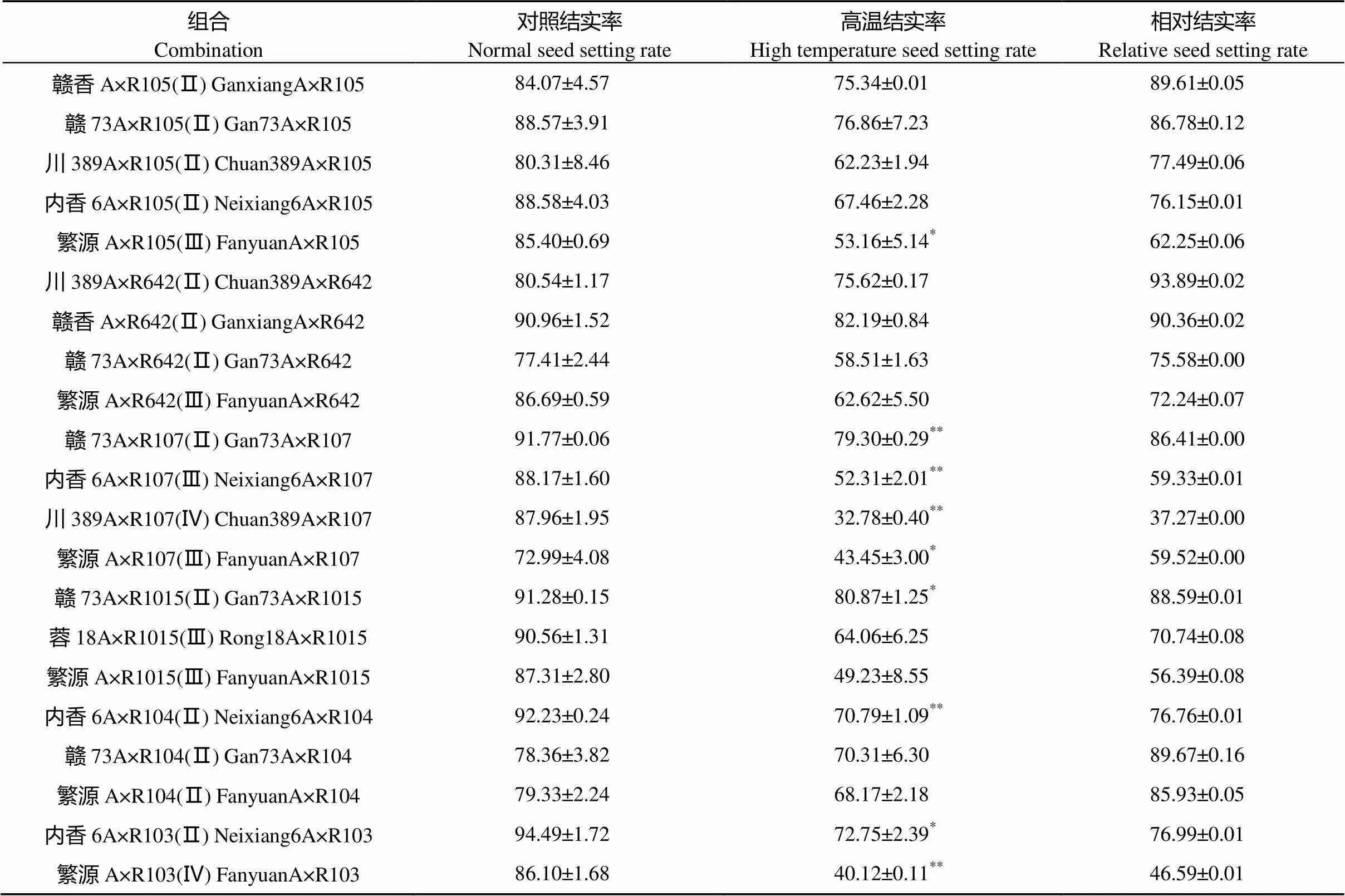
表6 不同父本、母本所配组合耐高温性分析
*和**代表同一恢复系(品种)在高温、常温处理下差异显著(≤0.05)和极显著(≤0.01)。相对结实率=高温处理结实率/对照处理结实率×100%。* and ** indicate significant differences between treatments of normal temperature and high temperature of the same restorer line (combination) at 0.05 and 0.01 levels, respectively. Relative seed setting rate = high temperature seed setting rate / normal temperature seed setting rate × 100%.
2.5 606A、608A等不育系与不同常规优质稻配组组合耐高温性分析
不育系606A和608A分别与9个常规优质稻配组(表7), 配出的18个组合中仅‘606A×黄占’为耐热杂交稻组合, 说明不育系606A和608A的耐高温配合力较低。中64香A与4个优质稻配组, 只有‘中64香A×金10’是耐热杂交稻组合, 而‘金10’与4个不同不育系杂交配组, 其中有2个组合被鉴定为耐高温水稻, 另一个组合对照结实率和相对结实率均大于65%, 由此可知, ‘金10’耐高温配合力较好。
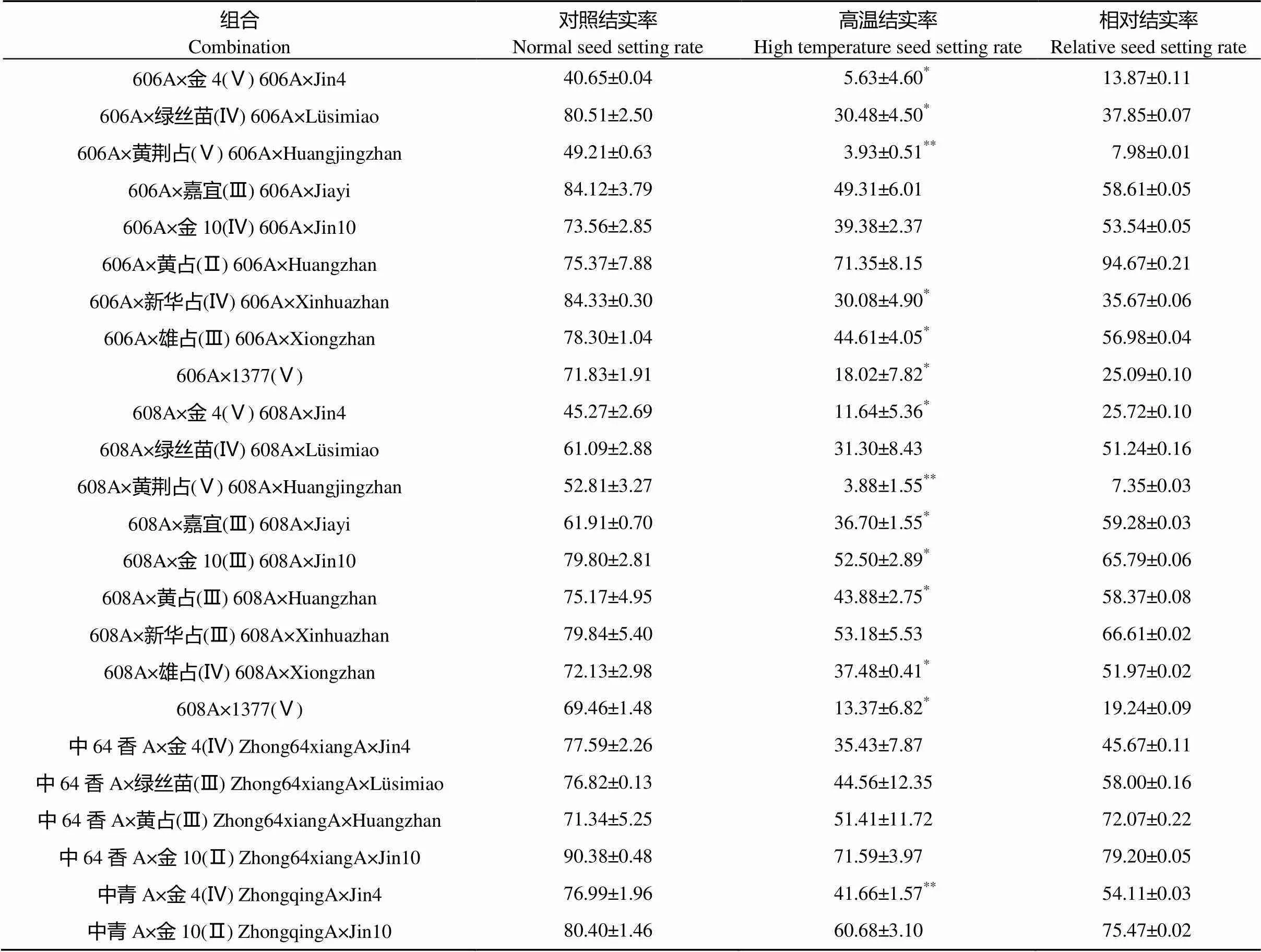
表7 不同不育系与不同常规优质稻所配组合耐高温性分析
*和**代表同一恢复系(品种)在高温、常温处理下差异显著(≤0.05)和极显著(≤0.01)。相对结实率=高温处理结实率/对照处理结实率×100%。* and ** indicate significant differences between treatments of normal temperature and high temperature of the same restorer line (combination) at 0.05 and 0.01 levels, respectively. Relative seed setting rate = high temperature seed setting rate / normal temperature seed setting rate × 100%.
3 讨论
3.1 杂交水稻耐热性鉴定分级方法
由于划分耐热与敏感型品种的标准是人为的, 同一品种在不同试验条件下的耐热性都有所不同, 以往的研究并没有统一的标准对供试水稻材料进行耐热性分级鉴定。因此, 为了提高试验结果的可靠性以及对指导生产布局的针对性与实用性, 本试验参考农业部颁布的高温行业标准(NY/T 2915—2016), 对供试材料及品种进行了耐热性鉴定分级, 并将高温行业标准中的高温处理时间从3 d延长到了5 d, 优化了试验条件, 以保证供试材料在高温处理期完全开放, 提高了试验结果的准确性和可靠性。
3.2 水稻父母本与品种(组合)耐高温关系
水稻亲本与品种(组合)之间的耐高温关系, 前人一直都有研究。杨成明等[13]将‘Ⅱ优838’与‘Ⅱ优718’及其父本进行高温试验, 发现父本对高温耐性的贡献率大于母本。符冠富等[8]研究表明水稻恢复系多属于不耐热性品种, 丰产性较好的恢复系大多耐高温能力不强。胡声博等[10]研究表明大部分具有相同母本的组合表现出一致的耐热性, 说明母本对杂交水稻的耐热性起主导作用。吕直文等[14]则研究表明杂交水稻品种(组合)的耐热性与其亲本材料的耐热性都是相关的。本试验通过不同父本与其杂交水稻组合之间在开花期人工高温与常温条件下的耐热性分析可知, 父本耐高温性好, 不一定品种(组合)耐高温性都好, 这还与父本配合力、母本的耐高温性及配合力有关。例如, R105和R107耐高温性均较好, 而同时与赣73A、内香6A、川389A、繁源A 4个不育系配组后, 除‘繁源A×R105’为中间型组合外, R105其余3个组合均为耐高温组合, 而R107所配组合仅‘赣73A×R107’为耐高温组合, 其余3个组合全为中间型组合。因此, 品种(组合)的耐热性还与父本的配合力以及母本耐热性及配合力相关。而父本耐高温性不好, 不一定品种(组合)耐高温性都不好。例如成恢727为极不耐热恢复系, 但其配合力较好, 配出的品种有一半多为耐热杂交稻品种, R104也是如此, 自身耐热性不强, 但配合力好, 配出的组合也多为耐热型组合。母本也是一样, 耐热配合力好的母本配出的组合多为耐热型组合, 如赣73A, 配合力差的母本配出的组合多为不耐热型组合, 如繁源A。综上所知, 为了更好更多地育成耐热性强的杂交稻组合, 筛选耐热配合力高的亲本是关键。
4 结论
1)参考2016年10月农业部发布的高温行业标准(NY/T 2915—2016), 以相对结实率≥95%为强耐热型, 75%≤相对结实率<95%为耐热型, 55%≤相对结实率<75%为中间型, 35%≤相对结实率<55%为不耐热型, 相对结实率<35%为极不耐热型对供试恢复系进行分级, 筛选鉴定出1个极耐热恢复系R4093、9个耐热恢复系(其中包括丰产性较好的恢复系, 如R1015, R107等), 4个极耐热品种(组合)和25个耐热品种(组合), 以及5个极不耐热恢复系、12个不耐热品种(组合)和6个极不耐热品种(组合)等。其中, 耐高温对照N22、恢复系R103、R132、R642, 杂交水稻品种(组合)‘川优5727’、‘宜香2115’、‘繁源A×R642’、‘中64香A×黄占’、‘川农优华占’、‘蓉18A×R1015’、‘渝香6203’和‘川优5727’在本试验中的常温结实率和相对结实率均高于70%, 虽然被鉴定为中间型材料, 但具有较大的耐高温潜力。试验还讨论了水稻恢复系和品种的生产布局, 第Ⅰ级和第Ⅱ级耐高温性较好, 可布局在高温易发区、高温轻发区和无高温区。第Ⅲ类为中间型, 可布局在高温轻发区和无高温区。第Ⅳ类和第Ⅴ类为不耐热型和极不耐热型, 可布局在无高温区, 以避免高温对水稻的伤害。
2)父(母)本耐高温性好, 不一定品种(组合)耐高温性都好, 而父(母)本耐高温性不好, 其品种(组合)耐高温性也不一定不好, 这还与父(母)本的耐高温性及配合力有关。耐热配合力好的父(母)本配出的组合多为耐热型组合, 耐热配合力差的父(母)本配出的组合多为不耐热型组合。试验结果表明, 恢复系R105、R642、R104和R727耐高温配合力较好, 但恢复系R107、R1015耐高温配合力相对较差。不育系赣73A和内香6A的耐高温配合力较好, 而繁源A、606A、608A和中64香A的耐高温配合力较差。优质稻中‘金10’耐高温配合力较好。为了更好更多地育成耐热性强的杂交稻组合, 筛选耐热配合力高的亲本是关键。
[1] 万丙良, 周亚贞, 査中萍, 等. 水稻恢复系R1056的耐热性鉴定及育种应用评价[J]. 湖北农业科学, 2014, 53(4): 753–757 WAN B L, ZHOU Y Z, ZHA Z P, et al. Evaluation of heat tolerance and breeding application of rice restorer line R1056[J]. Hubei Agricultural Sciences, 2014, 53(4): 753–757
[2] MATSUI T, OMASA K. Rice (L.) cultivars tolerant to high temperature at flowering: Anther characteristics[J]. Annals of Botany, 2002, 89(6): 683–687
[3] MATSUI T, KOBAYASI K, KAGATA H, et al. Correlation between viability of pollination and length of basal dehiscence of the theca in rice undera hot-and-humid condition[J]. Plant Production Science, 2005, 8(2): 109–114
[4] RANG Z W, JAGADISH S V K, ZHOU Q M, et al. Effect of high temperature and water stress on pollen germination and spikelet fertility in rice[J]. Environmental and Experimental Botany, 2011, 70(1): 58–65
[5] 陶龙兴, 谈惠娟, 王熹, 等. 超级杂交稻国稻6号对开花结实期高温热害的反应[J]. 中国水稻科学, 2007, 21(5): 518–524TAO L X, TAN H J, WANG X, et al. Effects of high temperature stress on super hybrid rice guodao 6 during flowering and filling phases[J]. Chinese Journal of Rice Science, 2007, 21(5): 518–524
[6] 张彬, 芮雯奕, 郑建初, 等. 水稻开花期花粉活力和结实率对高温的响应特征[J]. 作物学报, 2007, 33(7): 1177–1181 ZHANG B, RUI W Y, ZHENG J C, et al. Responses of pollen activity and seed setting of rice to high temperature of heading period[J]. Acta Agronomica Sinica, 2007, 33(7): 1177–1181
[7] 张桂莲, 刘思言, 张顺堂, 等. 抽穗开花期不同高温处理对水稻开花习性和结实率的影响[J]. 中国农学通报, 2012, 28(30): 116–120 ZHANG G L, LIU S Y, ZHANG S T, et al. Effects of different high temperature treatment on flowering characteristics and seed setting of rice during heading and flowering period[J]. Chinese Agricultural Science Bulletin, 2012, 28(30): 116–120
[8] 符冠富, 宋健, 廖西元, 等. 中国常用水稻保持系及恢复系开花灌浆期耐热性评价[J]. 中国水稻科学, 2011, 25(5): 495–500 FU G F, SONG J, LIAO X Y, et al. Thermal resistance of common rice maintainer and restorer lines to high temperature stress during flowering and early grain filling stages[J]. Chinese Journal of Rice Science, 2011, 25(5): 495–500
[9] 陈云风, 黎世龄, 罗筱平, 等. 水稻抽穗扬花期抗高温品系筛选试验[J]. 广东农业科学, 2017, 44(2): 1–5 CHEN Y F, LI S L, LUO X P, et al. Screening of high temperature resistant strains of rice during heading and flowering period[J]. Guangdong Agricultural Sciences, 2017, 44(2): 1–5
[10] 胡声博, 张玉屏, 朱德峰, 等. 杂交水稻耐热性评价[J]. 中国水稻科学, 2012, 26(6): 751–756 HU S B, ZHANG Y P, ZHU D F, et al. Evaluation of heat resistance in hybrid rice[J]. Chinese Journal of Rice Science, 2012, 26(6): 751–756
[11] 熊洪, 徐富贤, 朱永川, 等. 四川杂交水稻品种耐高温特性研究[J]. 中国稻米, 2011, 17(3): 1–4 XIONG H, XU F X, ZHU Y C, et al. Study on characteristic of resistance to high temperature of hybrid rice combination in Sichuan Province[J]. China Rice, 2011, 17(3): 1–4
[12] 张林, 熊洪, 徐富贤, 等. 西南杂交水稻抽穗开花期耐热性筛选[J]. 中国稻米, 2014, 20(3): 44–47 ZHANG L, XIONG H, XU F X, et al. Screening of heat resistance at flowering stage in hybrid rice in the southwest China[J]. China Rice, 2014, 20(3): 44–47
[13] 杨成明, 吴孝波, 刘勇强, 等. 气温对杂交水稻Ⅱ优718结实率的影响分析[J]. 西南农业学报, 2008, 21(6): 1519–1526 YANG C M, WU X B, LIU Y Q, et al. Effect of air temperature on the seed-setting rate of hybrid rice variety Ⅱ You 718[J]. Southwest China Journal of Agricultural Sciences, 2008, 21(6): 1519–1526
[14] 吕直文, 严明建, 黄成志, 等. 水稻亲本材料及其杂交组合开花灌浆期耐热性评价[J]. 种子, 2016, 35(7): 69–72 LYU Z W, YAN M J, HUANG C Z, et al. Evaluation on heat-resistance of rice parents and their hybrid rice combinations to high temperatue stress during flowering and early grain filling stages[J]. Seed, 2016, 35(7): 69–72
Evaluation of heat resistance of hybrid rice restorer lines and combinations*
GUO Xiaoyi, XIONG Hong, ZHANG Lin, JIANG Peng, ZHU Yongchuan, ZHOU Xingbing, LIU Mao, XU Fuxian**
(Rice and Sorghum Institute, Sichuan Academy of Agricultural Sciences / Key Laboratory of Southwest Rice Biology and Genetic Breeding, Ministry of Agriculture / Crop Ecophysiology and Cultivation Key Laboratory of Sichuan Province, Deyang 618000, China)
In order to reduce the impact of high temperature stress on rice, it is a priority importance in research to explore resistance of rice varieties to high temperature. Reference to industry standard evaluation index for high temperature issued by the Ministry of Agriculture, high temperature resistance characteristics of newly bred restorer lines and commonly used restorer line ‘Chenghui727’ were identified in production at the highest temperature of 38 ℃ and normal temperature treatment in artificially-controlled climatic conditions. Combinations of the restorer lines and varieties were divided into five grades. The heat resistance of different parents and hybrid rice combinations was also analyzed at artificially controlled high temperature and room temperature during flowering period. The results showed that: 1) One extremely heat resistant restorer line R4093, 9 heat resistant restorer lines (including high fertility restorer lines such as R1015, R107, etc.), 4 extremely heat resistant varieties (combinations) and 25 heat resistant varieties (combinations), 5 extremely heat-sensitive restorer lines, 12 heat-sensitive varieties (combination) and 6 extremely heat-sensitive varieties (combination) were screened and identified. Among these, seed setting rate of high temperature resistant control N22, restoration line R103, R132 and R642, hybrid rice varieties (combination) ‘Chuanyou5727’, ‘Yixiang2115’, ‘FanyuanA × R642’, ‘Zhong64xiangA × Huangzhan’, ‘Chuannongyouhuazhan’, ‘Rong18A × R1015’, ‘Yuxiang6203’ and ‘Chuanyou5727’ were more than 70% in this experiment. Although identified as intermediate materials, these lines (varieties) had high potential for high temperature resistance, as further discussed on the production layout of rice varieties. It was concluded that high temperature resistance grade Ⅰ and grade Ⅱwere better and could be arranged in high temperature prone areas, light high temperature areas and high temperature free zones. Grade Ⅲ was an intermediate type that could be arranged in light high temperature areas and high temperature free zones. The grade Ⅳ and Ⅴ were heat sensitive and extremely heat sensitive. These lines could be arranged in a high temperature free zone to avoid high temperature damage to rice. 2) It was also found that the varieties (combinations) with high temperature resistant father (mother) were not always high temperature resistant, while those with high temperature sensitive father (mother) were not always high temperature sensitive. It was also related to the heat resistance and combining ability of the parents. The combination of parents with good heat resistance and good combining ability was mostly heat resistant, and the combination of the parents with poor heat resistance and poor combining ability was mostly heat sensitive. The results showed that the restorer lines R105, R642, R104 and R727 had better high temperature combining ability, but the combining ability of the restorer lines R107 and R1015 was relatively poor. The high temperature combining abilities of male sterile line Gan73A and Neixiang6A were better, while the high temperature combining abilities of FanyuanA, 606A, 608A and Zhong64xiangA were poor. The combination ability of conventional high quality rice variety ‘Gold10’ was better. Therefore, in order to breed more heat resistant hybrid rice combinations, screening parents with high heat resistant combining ability was critical.
Agricultural industry standard; Hybrid rice; Restorer line; High temperature stress; Heat resistance; Parents; Combining ability
, E-mail: xu6501@163.com
Jan. 2, 2018;
Apr. 4, 2018
10.13930/j.cnki.cjea.180004
S428
A
1671-3990(2018)09-1343-12
徐富贤, 主要研究方向为水稻生理、生态及栽培技术研究。E-mail: xu6501@163.com 郭晓艺, 主要研究方向为水稻逆境缓解栽培技术与抗病育种研究。E-mail: guoxiaoyi9@163.com
2018-01-02
2018-04-04
* This study was supported by the National Key R&D Program of China (2017YFD0300400).
* 国家重点研发计划项目(2017YFD0300400)资助
郭晓艺, 熊洪, 张林, 蒋鹏, 朱永川, 周兴兵, 刘茂, 徐富贤. 杂交水稻恢复系和杂交组合的耐热性评价[J]. 中国生态农业学报, 2018, 26(9): 1343-1354
GUO X Y, XIONG H, ZHANG L, JIANG P, ZHU Y C, ZHOU X B, LIU M, XU F X. Evaluation of heat resistance of hybrid rice restorer lines and combinations[J]. Chinese Journal of Eco-Agriculture, 2018, 26(9): 1343-1354

